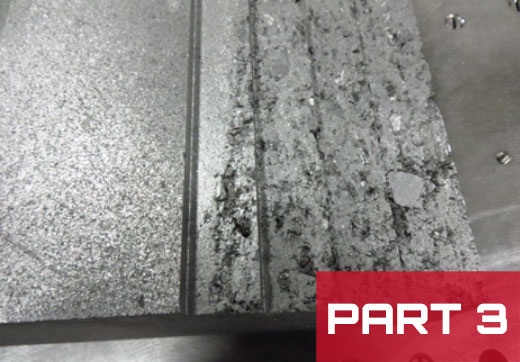
Graphite Material Quality #3 Graphite Defects
Series Introduction:
Semco has made its name in graphite manufacturing, an industry that requires great investment in tools, technology, and training. Our machining capabilities and ability to customize graphite elements for clients’ manufacturing systems make us a go-to for companies that require industrial components made of carbon. This series of blogs will focus on a more behind-the-scenes, but no less important, aspect of our business: the selection and utilization of high-quality graphite material. At Semco, we take choosing the right graphite grade for each project very seriously because we know that the finished component, no matter how skillfully tooled, will only be as effective and durable as the material with which it is made. Occasionally, a client will request that we use their graphite material. To these requests, we generally respond that we prefer to provide the graphite (although we do take jobs where the client insists we use their graphite). This series of blogs will explore what can go wrong with graphite material and why it is crucial to any project that raw material be examined and chosen by experts in the field of graphite manufacturing.
Graphite defects:
 One of the most common defects that we encounter in graphite material is actually defects that result from improper or careless handling of the raw material. Graphite is a strong material that can withstand great compressive, flexural forces. In the right conditions, it can withstand temperatures in the thousands of degrees celsius. That said, graphite is generally brittle and prone to mishaps that can affect the material’s quality and, if not spotted, the components manufactured from this material.
One of the most common defects that we encounter in graphite material is actually defects that result from improper or careless handling of the raw material. Graphite is a strong material that can withstand great compressive, flexural forces. In the right conditions, it can withstand temperatures in the thousands of degrees celsius. That said, graphite is generally brittle and prone to mishaps that can affect the material’s quality and, if not spotted, the components manufactured from this material.
From the time of graphite production in the manufacturing facility until the graphite is utilized by the end user in the form of a machined component, at every step in between, operators have a chance to damage the graphite. One type of damage we frequently observe is damage caused by towmotor forks. If the forks hit the graphite, the material can, and often does, crack. When that happens, chunks of the material can break from the parent material. In fact, in these instances when cracks form in the material, the best outcome is for a chunk of graphite to break off, thus clearly exposing the crack. Things gets tricky when a crack develops that doesn’t visually impact the integrity of the material. In these cases, if the crack is not discovered, the damaged material is manufactured into a flawed component. This is an outcome we at Semco work hard to prevent.
While some cracks result from the handling of material, other defects in the graphite can occur due to the improper mixing of the raw ingredients during graphite production. If material is mixed improperly—for example, the graphite is not mixed for enough time, or the equipment in which it is mixed was not cleaned properly prior to mixing), then cracks can form anywhere within the block or rod. A visual inspection of the raw material might not reveal any defects. Only cutting into the material or machining a product will reveal the defect clearly. In these difficult cases where an initial visual inspection does not reveal the issue, it is important to have in place a machining team dedicated to quality, that will alert management when they observe defects at any stage of the machining process. Semco trains all of our shop floor employees how to recognize defects in raw materials and what to do when they find them.
 Our team of crack graphite engineers (no pun intended) is tasked with finding many types of defects in the raw material we use in our machining shop. Every block of graphite is visually inspected, every custom blank is inspected before it is machined, and every part is inspected after being completed. Many times, hairline cracks can propagate through the material, and are not visible until the material is machined to the final shape. Hence, Semco encourages our customers to let us machine the final product. Do we offer raw material, or custom graphite blanks? Yes. Would we like to keep the process of selecting appropriate raw material in house, in order to insure full conformity. Absolutely.
Our team of crack graphite engineers (no pun intended) is tasked with finding many types of defects in the raw material we use in our machining shop. Every block of graphite is visually inspected, every custom blank is inspected before it is machined, and every part is inspected after being completed. Many times, hairline cracks can propagate through the material, and are not visible until the material is machined to the final shape. Hence, Semco encourages our customers to let us machine the final product. Do we offer raw material, or custom graphite blanks? Yes. Would we like to keep the process of selecting appropriate raw material in house, in order to insure full conformity. Absolutely.
